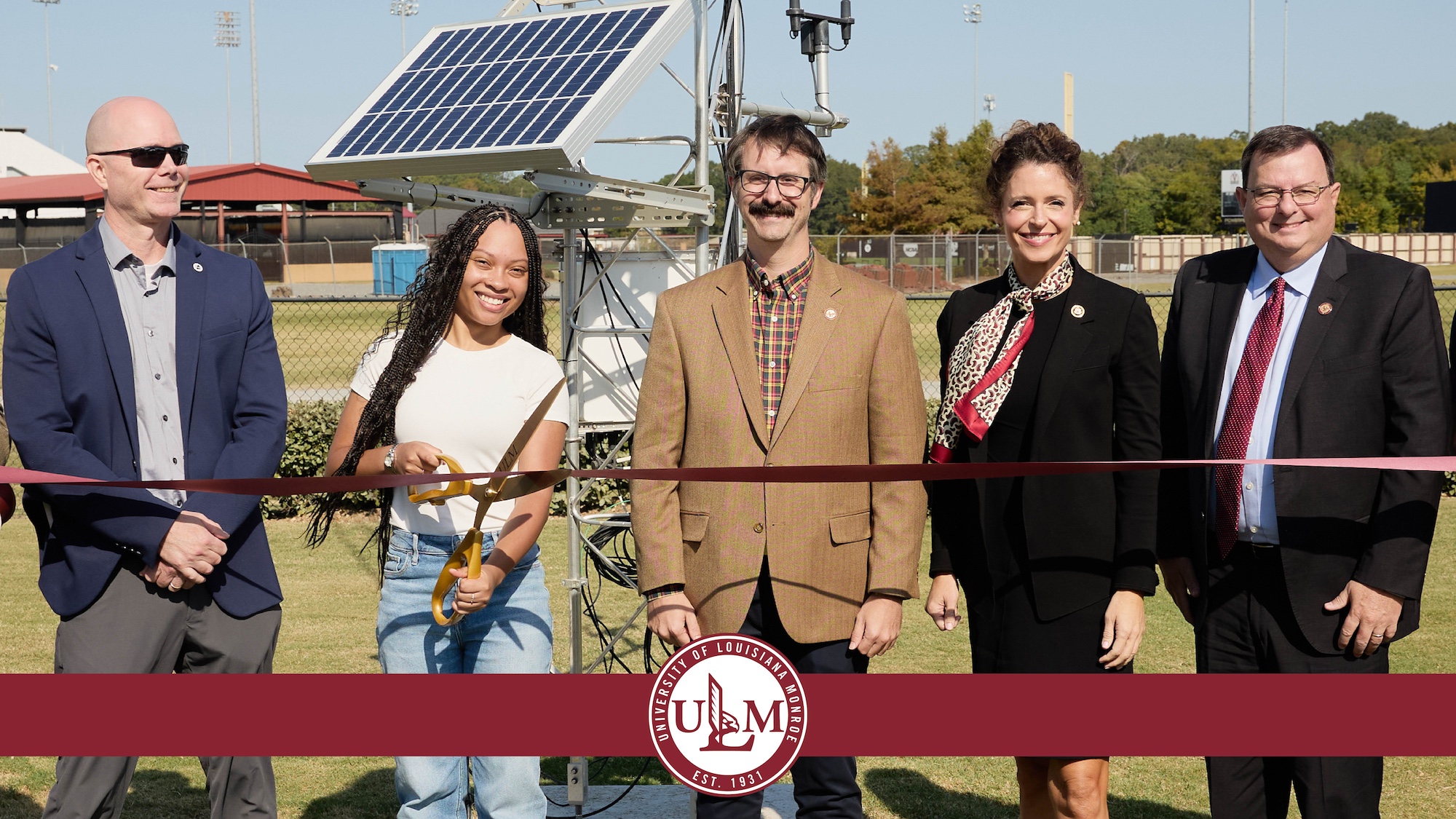Published October 15, 2024

CAPTION: (L-R) Brad Bryant, Meteorologist-in-Charge, National Weather Service Shreveport, Haniston Holloway, ULM Atmospheric Science student, Dr. Todd Murphy, Assoc. Director, ULM School of Sciences, Louisiana District 5 U.S. Representative
Julia Letlow, Dr. Ron Berry, ULM President
MONROE, LA – The University of Louisiana Monroe held a ribbon-cutting ceremony for the first installation
of the Louisiana State Mesonet, an interconnected network of instrumented weather
monitoring stations. The ceremony was held on the ULM campus at the mesonet site located
adjacent to University Park on Bon Aire Dr. Special guest speakers included Louisiana
District 5 U.S. Representative Julia Letlow, whose leadership helped secure the funding
for the project, and Brad Bryant, Meteorologist-in-Charge for the National Weather
Service in Shreveport.
“This day really isn’t about me; it’s about the incredible work that has culminated
in something that is so incredibly awe-inspiring, and I’m just proud to be a small
part of it,” said Letlow.
Letlow sits on the U.S. House Committee on Appropriations. She was able to help secure
$2 million of federal funding for the Louisiana State Mesonet as part of the Commerce,
Justice, Science, and Related Agencies Appropriations Act of 2023.
“I'm so thankful that earmarks like this are back because it’s a way to directly bring
those dollars back to the district that you serve, straight into the hands of universities
that you believe in that are transforming lives,” said Letlow.
Dr. Todd Murphy, Associate Director of the ULM School of Science and Associate Professor
of Atmospheric Science, has overseen the project since its inception. He acknowledged
the growth that has been able to take place due to the hiring of Mesonet Manager Emily
Newby and Mesonet Technician Dylan Hall, who have been instrumental in working with
landowners across the state to secure mesonet sites.
Murphy noted that one of the goals of the mesonet is to fill coverage gaps across
the state where there has been little weather data available. “We are trying to put
these towers where there is a void of data, so the weather service can get better
information, so they can issue more timely warnings and watches and provide better
data to the public to protect life and property,” said Murphy.
“It is such a privilege to have instrumentation like this readily available on campus,”
said senior Atmospheric Science major Haniston Holloway, who spoke at the ribbon cutting.
“As much as we do in the classroom, it helps broaden our knowledge to have this machinery
and understand how it works,” she added.
Brad Bryant, Meteorologist-in-Charge for the National Weather Service in Shreveport
says the strategically placed mesonet sites will provide data that is essential to
the mission of the National Weather Service. “The network will have an impact that
goes far beyond just our agency, but it will be a critical tool for emergency managers,
transportation officials, and the public, thus an invaluable asset to the communities
we serve,” said Bryant.
“I want to thank our Atmospheric Science faculty for their innovative ideas, and their
efforts to put this project together. It can truly help save lives across the state
of Louisiana,” said ULM President Ron Berry. “We wouldn’t be here today if it weren’t
for someone who believes in that mission with us. Congresswoman Letlow, thank you
so much for all you do for us and for the 5th district and the state. You are helping us realize our vision. We are great partners,
and we are fortunate to have you fighting on our behalf,” added Berry.
The Louisiana State Mesonet, currently has four fully functional sites, with a goal
of having 15 operational sites by the end of 2024. The completed mesonet will initially
include 50 weather stations installed in weather data gaps across the state of Louisiana.
This network measures temperature, humidity, pressure, solar radiation, wind speed
and direction, precipitation, and soil conditions. The mesonet and its data will be
used for critical weather and climate monitoring that will affect sectors such as
severe and hazardous weather forecasting, homeland security and emergency management,
aviation, energy and renewables, agriculture, transportation, and education. To learn
more about the Louisiana State Mesonet and view real-time data from active mesonet
sites, visit mesonet.ulm.edu.

